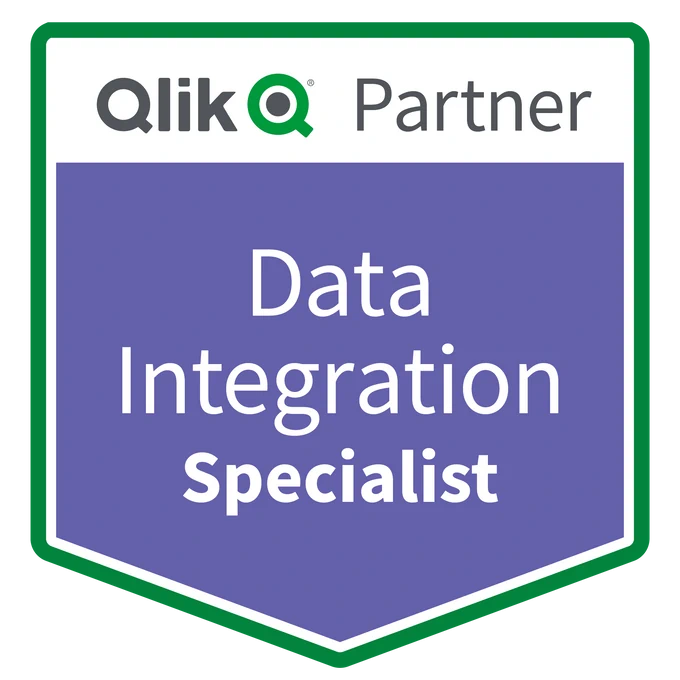Qlik Cloud Data Integration (QCDI)
Qlik Cloud Data Integration (QCDI) service is a”Real-time Data Integration Fabric for Modern DataOps”. Qlik Cloud Data Integration is an essential Qlik product for your organisation to achieve HyperAutomation and benefit from Active Intelligence.
“If your current #DataPipelines seem more like a 1995 screen saver with a maze of technical debt, Qlik can help you go from raw #data to #analytics ready in an automated way.” -Dalton Ruer
Understanding the need for Qlik Cloud Data Integration
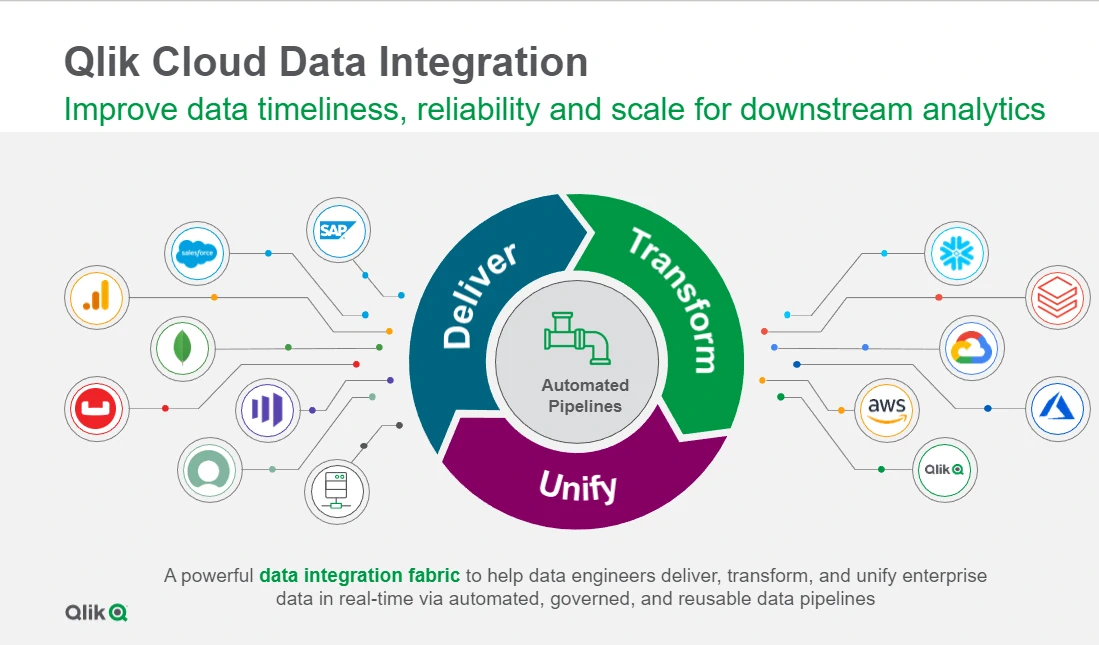
For your data to be active or ‘smart‘ it needs to be able to grow, change, move, and create new value. Smart data enables information vitality: your organisation will become nimble, agile, proactive, and responsive. Traditional data integration methods derive insights from ‘dormant’ or passive data sets that start to become dated, or even expire, as soon as they are captured. For organisations to achieve HyperAutomation and Active Intelligence they need access to their data, wherever, whenever, and however, they need it. You can energise your passive data to become smarter and proactive, with Active Intelligence.
Qlik Cloud Data Integration helps data engineers quickly deliver, transform, and unify enterprise data via automated, efficient, and governed data pipelines. QCDI ensures that data engineers can securely deliver data to the correct destination, in the right shape, in near real-time, regardless of where the data lives or the format that is required.
What is Qlik Cloud Data Integration?
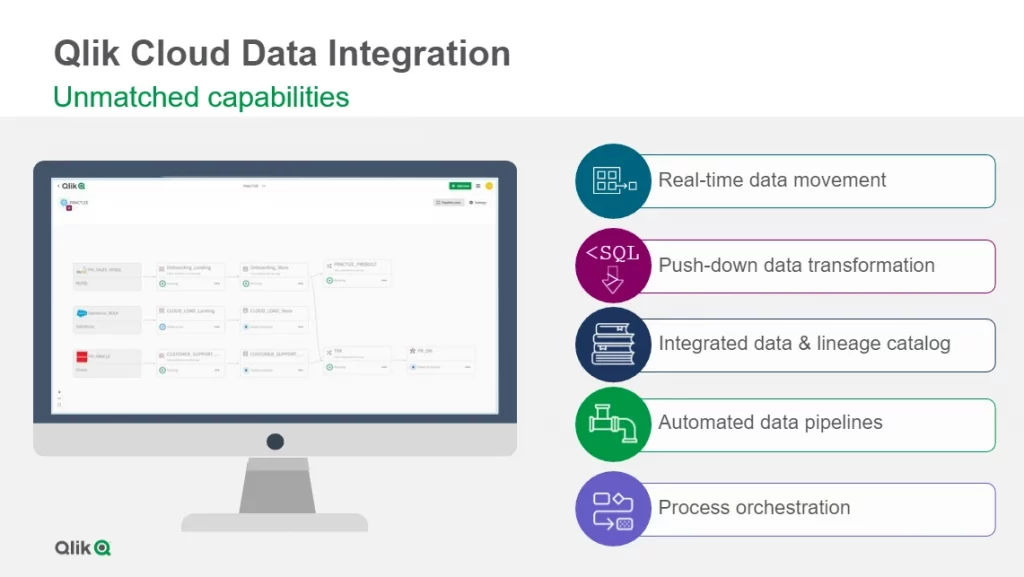
Qlik Cloud Data Integration is a flexible data fabric designed for data engineers to deliver, transform, and unify enterprise data in real-time via automated, governed, and reusable data pipelines. These pipelines improve data timeliness, reliability, and scale, which are essential for Active Intelligence and for every analytics, machine learning (ML), or digital transformation initiative.
Qlik Cloud Data Integration helps data engineers operationalise their DataOps processes via automated pipelines that catalogue and unify data, and transform raw data into trusted information to drive knowledgeable action in near real-time. Qlik Cloud Data Integration provides a variety of automated data integration styles and uses active metadata, lineage graphs, semantics, and machine learning to operationalise and streamline the data integration process.
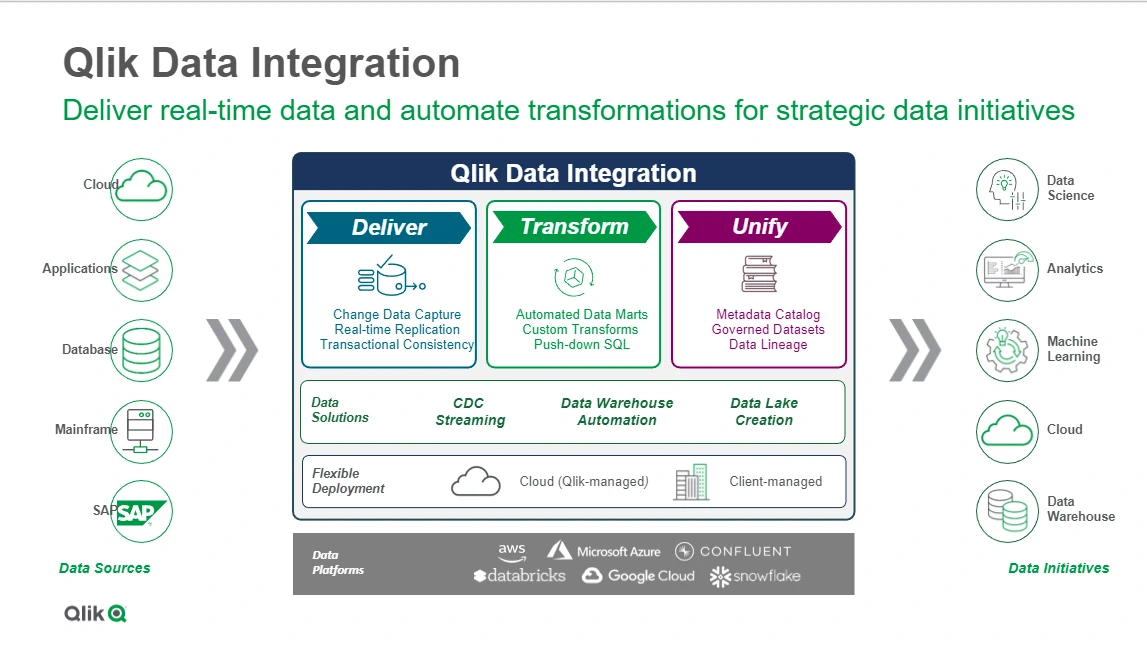
Qlik Cloud Data Integration core data services
Qlik Cloud Data Integration provides the following core data services to securely deliver an organisation’s data in near real-time, to the correct destination, in the right shape regardless of the platform or format at source:
- Real-time data movement
- Data transformation
- Application integration
- Metadata catalogue and lineage
- Data warehouse automation
Qlik Cloud Data Integration also leverages common Qlik platform services that make an entire enterprise’s data easy to find, manipulate, analyse, and govern.
It’s important to note that Qlik’s data services are cloud, data architecture, and methodology agnostic but they automate data discovery, integration, transformation, governance, and consumption at an enterprise level. Qlik Cloud Data integration is a complete solution, as opposed to separate components stacked together. Qlik refers to this as their Enterprise Integration Platform as a Service (eiPaaS).
Why Qlik Cloud Data Integration is stress-free
Not only is QCDI entirely cloud-based (SaaS) but your organisation will have the ability to unify all of its data in near-real time. The automated pipelines can be both designed and managed through cloud-based interfaces for various data integration patterns and consumption.
QCDI being platform agnostic is a major strength and de-stressor. With QCDI your organisation can utilise any data, any cloud access, any architecture pattern, and any data consumption. What are the benefits of this freedom?
- Improved data timeliness and quality for business-critical and data-driven initiatives
- Greater collaboration between data analysts and data engineers
- Faster time to market for data-intensive initiatives
- Greater operational efficiency with automated data pipelines
- Increased data visibility and accountability through catalogue and lineage
QCDI is a comprehensive offering, it includes change data capture (CDC), SaaS connectivity, the metadata catalogue, automation, transformation templates, app-to-app integration workflow, governance & lineage (knowledge graph) and Auto ML. QCDI has everything your organisation needs for cloud data integration.
Top three reasons to upgrade/migrate to Qlik Cloud Data Integration
1. Best in class real-time data movement
QCDI is a market leader when it comes to real-time change data capture. However, when investing in any new changes to your organisation’s infrastructure it’s important to consider the product’s impact on your organisation’s ESG (Environmental Social Governance). QCDI is both efficient and secure. It is enterprise-grade, has high performance, and secure on-premise to cloud data sync.
QCDI offers total freedom of data movement due to it being open and platform agnostic. QCDI can deliver data from virtually any source to any target from on-premises enterprise systems such as mainframes or SAP, to cloud destinations including Snowflake, Databricks, Azure Synapse, Google BigQuery. QCDI also enables multi-modal data transfer which allows for greater nimbleness and even more freedom of data movement by allowing full loads, incremental loads, change data capture (CDC), and application programming interface (API) connectivity.
2. Automated data pipelines for greater agility and data engineering productivity
By utilising automated data pipelines with push-down SQL, data engineers can accelerate the development of their data projects by defining reusable transformations that set data policy, generate logic, and automatically schedule push-down execution.
Data engineers can simplify their most complex data transformation workloads with project-based transformations for data lake and warehouse automation. Data engineers can create projects that codify and encapsulate DataOps best practices.
For even greater agility, QCDI allows for app-to-app integration. Data engineers can visually integrate SaaS applications with a low-code solution. Aggregate singular app flows to orchestrate more extensive enterprise-wide data processes.
3. Data Governance for explainable analytics
QCDI has several features that enable hardened data governance, an essential component of ESG. These features allow for data governed for explainable analytics:
- An integrated Metadata Catalogue: For easy data discovery, profiling and quality.
- A powerful Lineage & Knowledge Graph: Trusted data – visibility to the active metadata within the enterprise.
- Analytics that are driven by machine learning: Use data from pipelines to drive and derive operational analytics and governance.
Qlik Cloud Data Integration Use Cases
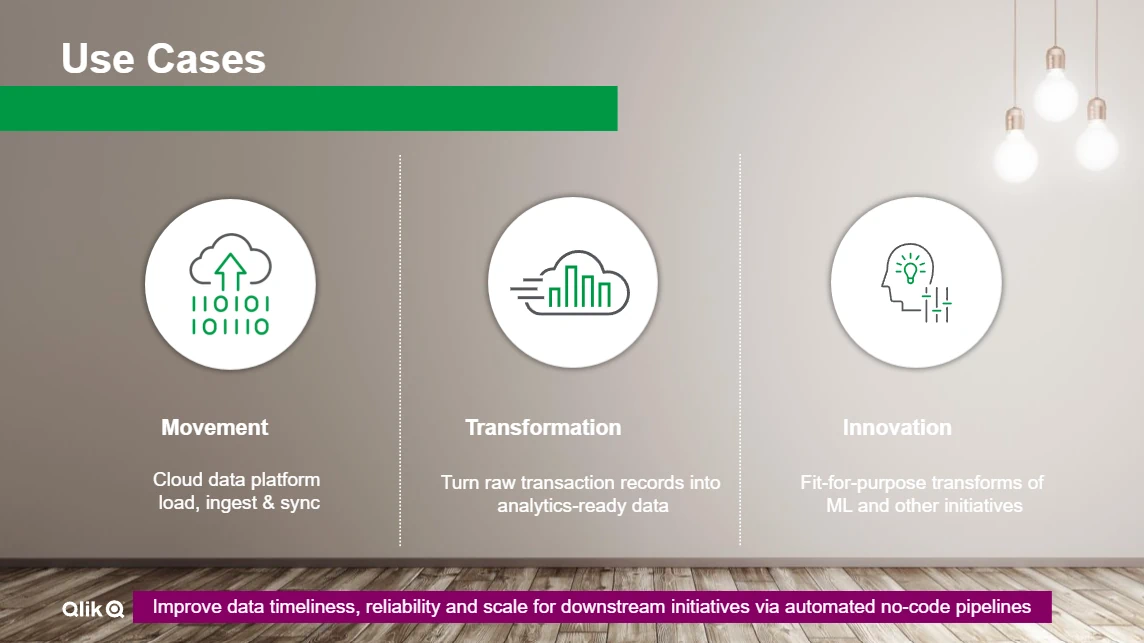
“How would I use Qlik Cloud Data Integration?”
Qlik Cloud Data Integration is a smart choice for cloud data migration, data transformation, and innovation to derive HyperAutomation and Active Intelligence.
Differentia Consulting is a certified Qlik Partner and Data Integration specialist. With Qlik Cloud Data integration we can help you achieve the following:
- Cloud Data Migration
Deploy data pipelines that continually integrate data from on-premise or cloud application systems into your cloud data platform of choice. This is also known as data warehouse loading/ingestion. Data engineers can build pipelines to ingest and update data warehouse tables. - Data transformation
Transformation is the classic ‘T’ in Extract Transform Load (ETL) or Extract Load Transform (ELT). Data engineers can transform raw transaction records by making the data conform to industry models for downstream analytics or BI processes. - Innovate with artificial intelligence and machine learning
Data Engineers can deploy pipelines to conform and curate data for new types of workloads, such as artificial intelligence (AI) and machine learning (ML) initiatives to enable proactive initiatives and decision-making. - Active Intelligence
Data Engineers can deploy data pipelines to propagate customer churn predictions derived from machine learning via a well-governed process throughout the enterprise.
Learn more about Qlik Cloud Data Integration
If you would like to find out more about Qlik Cloud Data Integration, please get in touch below:
